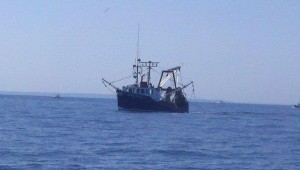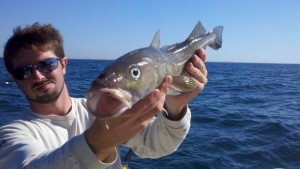Click here for the latest Cape Cod tuna fishing report
The commercial whiting season opens in October on Cape Cod Bay. This means that the whiting draggers will be working day in and day out in the deep waters off Provincetown, Plymouth and Stellwagen Bank.

The return of the whiting also creates an awesome giant tuna fishing opportunity. Giant bluefin tuna most likely suck down hundreds of whiting each week. Whiting are certainly an easy meal for these massive fish.
One of the most popular and effective ways to catch these tuna is by live lining whiting. Conveniently, you can catch whiting and fish for tuna in the same area.
An effective way to catch whiting is to use a spinning or conventional reel loaded with at least 150 yards of braided line. Braided line will make keeping bottom in up to 200 feet of water much easier. Since braid has zero stretch, it will also help you to detect bites.
The next step is to tie on your favorite sabiki rig. Since you will eventually run into dogfish, it's often smart to avoid light poundage test sabiki rigs-since the hooks will easily snap off when reeling up a big sand shark.

The most important thing to remember is to tip each sabiki hook with a piece of bait. This could be a piece of herring, mackerel, pogie-basically whatever bait you have on board. A one inch strip will work just fine.
We've had success using "tough" pieces of pogie or herring. What I mean by "tough" is a section of the herring or pogie that will remain on the hook during the long drop to the bottom. 200 feet of water is a long way down, so you want to make sure that the piece of bait you hook onto the sabiki rig is actually going to remain on the hook during the descent. One inch strips of pogie belly seem to stay on the hook pretty well.
It's also important to use enough weight to keep the line nearly vertical and in constant contact with the bottom. We've caught most of our whiting on the bottom, or a foot or two above the bottom. Holding bottom can be a challenge when the tide is ripping. Often times we have used over 10 ounces of weight.

If the wind and tide are not too strong, then drifting can work. Motoring slowly into the current and wind as your crew members jig can help your crew keep constant contact with the bottom. However the easiest method is to just anchor up and jig.
Speaking of jigging, so far I have not noticed any benefit from actually "jigging" the rod. Having a fully baited sabiki rig right above Cape Cod Bay's muddy bottom is usually enough to generate a bite.
Whiting are not the only fish you will catch using this method. Mud hake, cod, herring and mackerel will also latch onto a properly presented sabiki rig. Each of these fish will make good tuna bait.
Of course, expect to deal with plenty of dogfish as well!
Tight lines,
Ryan
As always comments are encouraged and appreciated!
Follow My Fishing Cape Cod on Facebook by clicking here.

